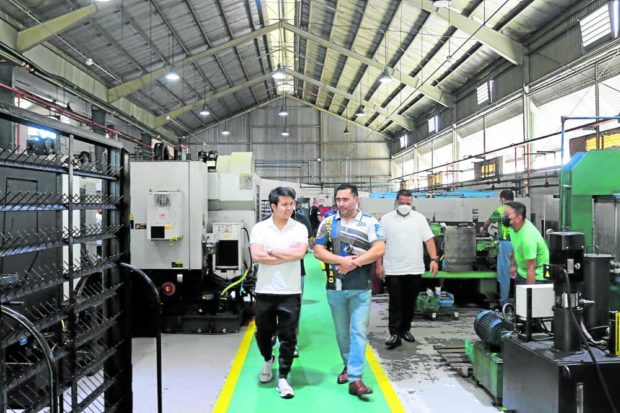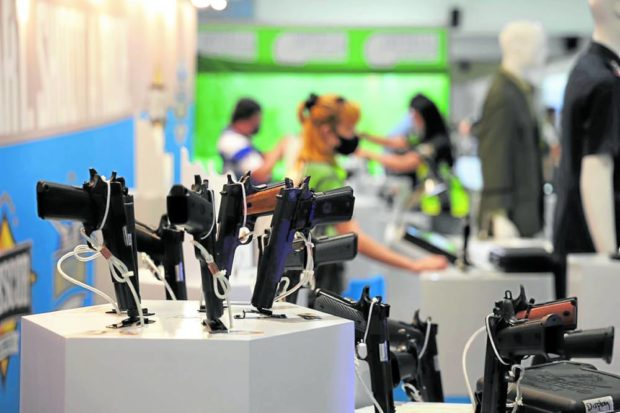Homegrown gun-maker captures offshore markets with a big bang

FACTORY TOUR Armscor president Martin Tuason (right) shows Brian Poe Llamanzares one of the company’s facilities in Marikina City that now uses robotics for more efficiency. —CONTRIBUTED PHOTOS
Why is it that a Filipino firearms manufacturer known and respected internationally—including the gun-loving American market where its pistols have a strong following—continues to struggle to convince people in its home market that it makes world-class products?
It is a question that bothers Armscor Global Defense Inc. president Martin Tuason as he continues on his mission to not only sell more guns in the world’s largest firearms market, but also to help build a self-sustaining defense industry in the Philippines that will meet the country’s national security needs while creating thousands of jobs for Filipinos.
“There’s still a lot of resistance locally,” he says in an interview at the company’s head office in Ortigas Center, Pasig City. “It’s like nobody really believes that the Filipino can. It’s really sad.”
To this day, the third generation Tuason running Armscor laments that local buyers from the private sector and government, still have a bias for imported firearms and ammunition. “Don’t get me wrong. [Foreign manufacturers] make great products,” he says. “But why not cultivate and develop an industry that can provide thousands and thousands of jobs for Filipinos?

LOCAL Pistols of various calibers are produced in Marikina.
Turning point
Fortunately for the Armscor chief, the tide of perception is turning. And the tipping point occurred during a crisis five years ago that tested the company’s ability to supply the government with critically needed weapons and ammunition.
In 2017, Islamic terrorists laid siege to Marawi, forcing the Armed Forces of the Philippines into pitched battles to reclaim the city—a conflict that lasted for five months, nearly exhausting the government’s ammunition supply early on.
“In 2017, we got to showcase what it means to have a local manufacturer,” Tuason says. “We delivered 3,000 guns in five days, with 300,000 rounds of ammunition for the troops. We were the only private company that was able to supply the AFP during the Marawi conflict. And we did it early, not late.”
In contrast, ammunition from other suppliers contracted under the government’s emergency procurement program arrived only in February 2018, almost four months after the conflict had ended.
“I was talking to the colonels and captains on the front line and they said they were rationing ammunition after the first three or four days of the conflict,” he says. Recognizing the urgency of the matter, he ordered Armscor to expedite the delivery of the guns and ammunition for the AFP.
“We got the call Monday morning and, by midnight of Friday, we delivered the guns,” he says, adding that, thanks to that experience, the company today has more allies and “champions” in government and the defense establishment who see the value of having a local firm that can meet local needs.
Past and future
Armscor traces its heritage back to 1905 when two Englishmen established a photography shop in Manila called Squires Bingham. It was later acquired by an American who turned it into a sporting goods store and then sold it to Celso Tuason in November 1941.
After the war, the store reopened and the Tuason patriarch decided to focus on the store’s most profitable product line: firearms. Soon after, it obtained the first firearms manufacturing license from the government—License No. 1—which it still holds to this day.
In 1958, the company moved to its present seven-hectare compound in what was, back then, rural Marikina. The second generation took over running the company in 1966 with Demetrio “Bolo” Tuason serving as its chief for 52 years, until Martin took over in 2012. Today, Armscor is the world’s largest manufacturer of 1911-format pistols (colloquially knows as the “45”).
But it wasn’t until 1995 when the firm started making this particular pistol and quality in the beginning was inconsistent. Tuason knew as early as 1999 that something had to change. So he revamped the firm, bringing in foreign technical consultants and implementing a lifetime product warranty that forced the people involved in manufacturing to “up their game.”
That change resulted in the manufacturing process evolving from what was essentially custom gun work to an assembly line system to the current state where robotics are used to make key components of every firearm.
“We went from producing five to six guns per day per assembler, to 35 to 40 today. The worst assembler does 30,” he says. And higher revenues in the company’s biggest market soon followed.
“In 1999, my dad’s best year in the US market was $802,000 [in] total sales,” says Tuason. “By the time I left sales in 2016, I had turned the US market into [one that delivers] $100 million in revenues.”
A cousin who now runs the sales division has since taken the company’s global sales past the $200-million mark.

ROBOTICS Tuason says automated manufacturing processes down rejection rates in Armscor factories to nearly zero.
Recently, Armscor opened its first robotics assembly line with 10 CNC (computer numerical control) machines that can manufacture components faster, safer, more accurately and more efficiently than human hands can.
The work that was once performed by as many as 40 people can now be done by two people for each of the three shifts that Armscor’s Marikina plant runs to keep up with demand. And shifting to robotics has cut the rejection rate in the metal sanding stage for its pistols from 19 percent to a mere 0.01 percent.
Rewarding ingenuity
More importantly, Tuason has implemented a management system that empowers his key employees to make the company better.
“I’ve cut their reins,” he says, explaining that he encourages staffers to come up with new ideas on how to improve business processes. “I told them I’ll reward ingenuity.”
And perhaps, most importantly, Tuason knows he doesn’t have a monopoly of knowledge in the firm despite having spent almost his entire life working the factory floors.
“In meetings, my people say ‘no’ to me all the time now,” he says. “Our people never said ‘no’ to my dad.”
That’s a good organizational mindset to have, whatever industry one is in—one which Tuason hopes will take Armscor far into the distant future.
READ: ARMSCOR giving back to the community through its expo
Disclaimer: The comments uploaded on this site do not necessarily represent or reflect the views of management and owner of Cebudailynews. We reserve the right to exclude comments that we deem to be inconsistent with our editorial standards.
